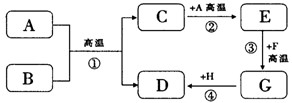问题
推断题
A~H都是初中化学中常见的物质,已知B为黑色固体,D为红色固体单质,F为红色固体,它们的转化关系如图所示。请回答:

(1)物质B的化学式为_________;
(2)反应①的化学方程式为_________________;写一个能实现反应④的化学方程式_________________;
(3)某兴趣小组利用反应③在实验室制取物质G。根据所得的物质G的质量,可求得参加反应的物质E的质量,但实际消耗的物质E的质量远远超过计算值,其原因可能是(从实验过程分析,任意答两点)_______________、_____________________。
答案
(1)CuO
(2)C+2CuO 2Cu+CO2;Fe+CuSO4==Cu+FeSO4等;
2Cu+CO2;Fe+CuSO4==Cu+FeSO4等;
(3)加热前要先通CO,排出装置内的空气;反应后热铁粉还需在CO中冷却;部分CO通过装有氧化铁的玻璃管时,未与氧化铁反应等。(其他合理答案均可)
